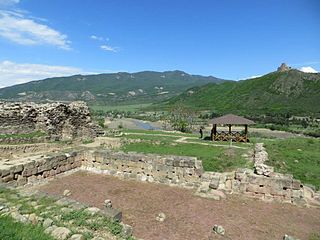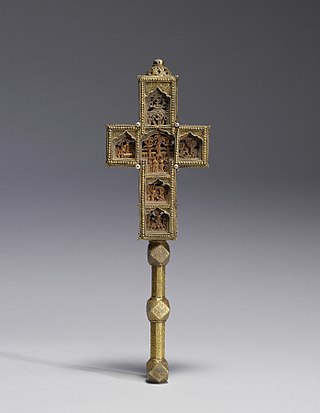Related Research Articles

The Bulgars were Turkic semi-nomadic warrior tribes that flourished in the Pontic–Caspian steppe and the Volga region during the 7th century. They became known as nomadic equestrians in the Volga-Ural region, but some researchers say that their ethnic roots can be traced to Central Asia. During their westward migration across the Eurasian steppe, the Bulgar tribes absorbed other tribal groups and cultural influences in a process of ethnogenesis, including Iranian, Finnic and Hunnic tribes. Modern genetic research on Central Asian Turkic people and ethnic groups related to the Bulgars points to an affiliation with Western Eurasian populations. The Bulgars spoke a Turkic language, i.e. Bulgar language of Oghuric branch. They preserved the military titles, organization and customs of Eurasian steppes, as well as pagan shamanism and belief in the sky deity Tangra.

In Greco-Roman geography, Iberia was an exonym for the Georgian kingdom of Kartli, known after its core province, which during Classical Antiquity and the Early Middle Ages was a significant monarchy in the Caucasus, either as an independent state or as a dependent of larger empires, notably the Sassanid and Roman empires. Iberia, centered on present-day Eastern Georgia, was bordered by Colchis in the west, Caucasian Albania in the east and Armenia in the south.

Pharnavaz I was a king of Kartli, an ancient Georgian kingdom known as Iberia in classical antiquity. The Georgian Chronicles credits him with being the first monarch founding the kingship of Kartli and the Pharnavazid dynasty, while other independent chronicles, such as The Conversion of Kartli make him the second Georgian monarch. Based on the medieval evidence, most scholars locate Pharnavaz's rule in the 3rd century BC: 302–237 BC according to Prince Vakhushti of Kartli, 299–234 BC according to Cyril Toumanoff and 284–219 BC according to Pavle Ingoroqva. Pharnavaz's rise, advent and imperial expansion of the Iberian monarchy was directly tied to the victory of Alexander the Great over the Achaemenid Empire. Pharnavaz ruled under the suzerainty of the Seleucid Empire.

Mirian III was a king of Iberia or Kartli (Georgia), contemporaneous to the Roman emperor Constantine the Great. He was the founder of the royal Chosroid dynasty.

Kartli is a historical region in central-to-eastern Georgia traversed by the river Mtkvari (Kura), on which Georgia's capital, Tbilisi, is situated. Known to the Classical authors as Iberia, Kartli played a crucial role in the ethnic and political consolidation of the Georgians in the Middle Ages. Kartli had no strictly defined boundaries and they significantly fluctuated in the course of history. After the partition of the kingdom of Georgia in the 15th century, Kartli became a separate kingdom with its capital at Tbilisi. The historical lands of Kartli are currently divided among several administrative regions of Georgia.
The Median language was the language of the Medes. It is an Old Iranian language and classified as belonging to the Northwestern Iranian subfamily, which includes many other languages such as Old Azeri, Talysh, Gilaki, Mazandarani, Zaza–Gorani, Kurdish, and Baluchi.
Bacurius was a Roman general and a member of the royal family of Iberia mentioned by several Greco-Roman authors of the 4th and 5th centuries. It is accepted, but not universally, that all these refer to the same person, an Iberian "king" or "prince", who joined the Roman military ranks. Scholarly opinion is divided whether Bacurius can be identified with one of the kings named Bakur, attested in medieval Georgian annals, who might have taken refuge in territories obtained by the Eastern Roman Empire during the Roman–Persian Wars that were fought over the Caucasus.

The Dulo clan was a ruling dynasty of the Bulgars, who were of Turkic origin. It is generally considered that their elite was related to the Huns and the Western Turkic Khaganate. Particularly, it is said that the Dulo descended from the rulers of Old Great Bulgaria. This state was a centralized monarchy from its inception, unlike previous Hunno-Turkic political entities, which were tribal confederations.
Amazasp I was a king of Iberia whose reign is placed by the early medieval Georgian historical compendia in the 2nd century. Professor Cyril Toumanoff suggests 106–116 as the years of his reign, and considers him to be the son and successor of Mithridates I of Iberia who is known from epigraphic material as a Roman ally. Toumanoff also identifies him with the Amazaspus of the Stele of Vespasian and Xepharnuges of the Stele of Serapit.

The Chosroid dynasty, also known as the Iberian Mihranids, were a dynasty of the kings and later the presiding princes of the early Georgian state of Iberia from the 4th to the 9th centuries. The family, of Iranian Mihranid origin, accepted Christianity as their official religion c. 337, and maneuvered between the Byzantine Empire and Sassanid Iran to retain a degree of independence. After the abolition of the Iberian kingship by the Sassanids c. 580, the dynasty survived in its two closely related, but sometimes competing princely branches—the elder Chosroid and the younger Guaramid—down to the early ninth century when they were succeeded by the Georgian Bagratids on the throne of Iberia.
Amazasp II was a king of Iberia and the last in the P’arnavaziani line according to the medieval Georgian chronicles. A son and successor of P’arsman III, he is assumed to have ruled in the latter quarter of the 2nd century, from 185 to 189 according to Cyril Toumanoff.

Armazi is a locale in Georgia, 4 km southwest of Mtskheta and 22 km northwest of Tbilisi. A part of historical Greater Mtskheta, it is a place where the ancient city of the same name and the original capital of the early Georgian kingdom of Kartli or Iberia was located. It particularly flourished in the early centuries AD and was destroyed by the Arab invasion in the 730s.

The Pharnavazid is the name of the first dynasty of Georgian kings of Kartli (Iberia) preserved by The Georgian Chronicles. Their rule lasted, with intermissions, from the 3rd century BC to the 2nd century AD. The main male line is reported to have become extinct early on and followed by houses related to it in the female line. By the close of the 2nd century AD, the Pharnavazid rule came to an end and the Arsacid Dynasty took over the crown of Iberia.
Bakur I, of the Arsacid dynasty, was a king of Iberia from 234 to 249.
Amazasp III or Hamazasp I was a king of Iberia from 260 to 265 AD. According to Cyril Toumanoff he may have been a scion of the Pharnavazid dynasty, while Richard N. Frye states that he was an Iranian, possibly related to the royal Sasanian family.
Bakur II, of the Chosroid Dynasty, was a king of Iberia from 534 to 547.

Phasis was an ancient and early medieval city on the eastern Black Sea coast, founded in the 7th or 6th century BC as a colony of the Milesian Greeks at the mouth of the eponymous river in Colchis. Its location today could be the port city of Poti, Georgia. Its ancient bishopric became a Latin Catholic titular see of Metropolitan rank.

Georgia is the Western exonym for the country in the Caucasus natively known as Sakartvelo. The Armenian exonym is Vrastan ; predominantly Muslim nations refer to it as Gurjistan or its many similar variations; while in mostly Slavic languages it is Gruziya.

Old Great Bulgaria or Great Bulgaria, also often known by the Latin names Magna Bulgaria and Patria Onoguria, was a 7th-century nomadic empire formed by the Onogur Bulgars on the western Pontic–Caspian steppe. Great Bulgaria was originally centered between the Dniester and lower Volga.

The Christianization of Iberia refers to the spread of Christianity in the early 4th century by the sermon of Saint Nino in an ancient Georgian kingdom of Kartli, known as Iberia in classical antiquity, which resulted in declaring it as a state religion by then-pagan King Mirian III of Iberia. Per Sozomen, this led the king's "large and warlike barbarian nation to confess Christ and renounce the religion of their fathers", as the polytheistic Georgians had long-established anthropomorphic idols, known as the "Gods of Kartli". The king would become the main sponsor, architect, initiator and an organizing power of all building processes. Per Socrates of Constantinople, the "Iberians first embraced the Christian faith" alongside the Abyssinians, but the exact date of an event is still debated. Georgian monarchs, alongside the Armenians, were among the first anywhere in the world to convert to a Christian faith. Prior to the escalation of Armeno-Georgian ecclesiastical rivalry and the christological controversies their Caucasian Christianity was extraordinarily inclusive, pluralistic and flexible that only saw the rigid ecclesiological hierarchies established much later, particularly as "national" churches crystallized from the 6th century. Despite the tremendous diversity of the region, the christianization process was a pan-regional and a cross-cultural phenomenon in the Caucasus, Eurasia's most energetic and cosmopolitan zones throughout the late antiquity, hard enough to place Georgians and Armenians unequivocally within any one major civilization. The Jews of Mtskheta, the royal capital of Kartli, that did play a significant role in the Christianization of the kingdom, would give a strong impetus to deepen the ties between the Georgian monarchy and the Holy Land leading to an increasing presence of Georgians in Palestine, as the activities of Peter the Iberian and other pilgrims confirm, including the oldest attested Georgian Bir el Qutt inscriptions found in the Judaean Desert alongside the pilgrim graffiti of Nazareth and Sinai.
References
- ↑ Hyun Jin Kim (2013). The Huns, Rome and the Birth of Europe. Cambridge University Press. p. 168. ISBN 9781107009066.
- ↑ Encyclopedia Iranica online: Asparukh a Middle Iranian proper name attested in ancient Georgia and early medieval Bulgaria.
- ↑ Bŭlgarski etimologichen rechnik, tom 1, Institut za bŭlgarski ezik (Bŭlgarska akademia na naukite) Vladimir Ivanov Georgiev, 1962, p.18.